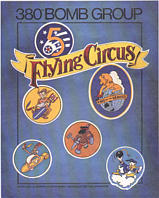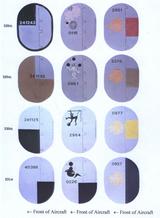 |
380th Bomb
Group Association
|
GROUP AND SQUADRON IDENTIFICATION BY TAIL MARKING
 |
380th Bomb
Group Association
|
As in all theatres, a problem soon arises when planes needed to formate or rendezvous prior to hitting the target. If more than one group was involved, it became very difficult to tell the different units apart and some form of highly visible identification became necessary. The presence of the large twin tails on the B-24 made them the logical place to put whatever identification symbols were employed.
This situation became critical in the Southwest Pacific area when MacArthur began preparations for the Cape Gloucester invasion of New Britain Island in late November 1943. all available bomber aircraft were scheduled to take part with three B-24 groups involved. An order was therefore issued for each group to pick a distinctive marking.
The 380th chose to paint the fins and rudders of their planes in a scheme of quadrants, as shown below. These pictures, for clarity, show the scheme after Spring 1944 (Northern Hemisphere seasons) when the OD paint was removed from our aircraft. The first version was to paint the chosen quadrant white on the OD background. As noted, this was changed to black on NMF (natural metal finish) the following April-June period.

This scheme was maintained until the move of the 380th to Mindoro, The Philippines, in February-March 1945 (i.e., 15 months). The following figure shows all the versions of tail markings for the 380th. The succeeding period schemes will be discussed in The Philippines Campaign volume of this work (Part VI), but note that the center panel of this figure shows the Flying Circus motif used in The Philippines and the right-hand column is for the King of the Heavies motif adopted for expected involvement in the Invasion of Japan from Okinawa, the latter fortunately halted by peace.

Source: Horton, King of the Heavies, p. 127.
Go to Aircraft Types Go to Aircraft Listing
Go to Part V Planes (for the aircraft used in the Australia/New Guinea Campaign) Go to Part V Introduction
Go to Part VI Planes (for the aircraft used in The Philippines Campaign) Go to Part VI Introduction